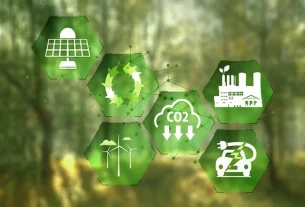
Limiting global warming to 1.5°C sees world emissions fall by 85% by 2050 compared to today’s levels, according to the latest edition of the annual Global Energy and Climate Outlook (GECO) report.
The share of fossil fuels in global energy trade drops by 80% in 2050 compared to today. Despite higher demand, particularly for transport, the share of hydrogen and of derived fuels – called e-fuels – in total global final energy consumption remains low in 2050, at 7% and 5% respectively, according to the study.
The modelling, carried out for different scenarios, finds that global emissions are still not on track to deliver on the temperature targets of the Paris Agreement. Both the reference scenario, capturing the current policy landscape, and the Nationally Determined Contributions and Long-Term Strategies scenario, additionally considering the currently announced climate targets globally, fall short of curbing the temperature rise at 1.5°C.
However, some progress was made in 2021. Policy action in major emitters and continued cost reductions and deployment of low-emission technologies limit the temperature increase in the reference scenario to 3.0°C by the end of the century, an improvement compared to the nearly 3.2°C projected temperature rise in the previous 2021 edition of GECO.
Energy trade on the way to 1.5°C
Fossil fuels currently represent almost the totality of global direct energy trade (data from 2015). Oil represents close to 60% of total directly traded energy, followed by gas (25%) and coal (15%).
In the 1.5°C scenario, the coming decade must be centred on phasing out fossil fuels, accelerating deployment of renewables and electrifying the bulk of final demand. The energy system undergoes a major restructuring, with fossil fuels reducing their collective share in the global primary energy mix to 21% by 2050, while solar, biomass and wind become the dominant forms of primary energy supply.
Domestic renewable deployment and electrification reduce the demand for fossil fuels, which in turn reduces the need to trade in them. This trend sees most regions reducing their reliance on imported energy, leading to a global increase in energy self-sufficiency.
In a 1.5°C scenario, energy trade is undergoing significant changes. Coal trade suffers the most from the decarbonisation effort, with global volumes of traded coal reduced by 88% compared to the reference scenario in 2050. Oil trade is reduced by 59% and fossil gas by 74%. Trade of low-carbon energy carriers, such as biomass, biofuels, hydrogen and e-fuels, is projected to increase, however these trade flows do not reach fossil fuel trade volumes.
Besides direct trade of energy carriers (such as coal, oil, gas, or hydrogen), the report also tracks energy that is embodied in goods that are traded internationally. Embodied energy of a product accounts for all the energy that was used along the entire value chain to produce it.
More than 60% of embodied energy that is traded across international borders today occurs in traded products of energy intensive and other manufacturing industries. The carbon intensity of traded goods is projected to substantially decrease in the 1.5°C scenario, as the composition of energy embodied transitions from one dominated by fossil fuels today to one of mostly renewable electricity in 2050.
The role of hydrogen in 1.5°C scenario
Hydrogen is used mostly in transport in 2050, accounting for 78% of total hydrogen demand in the 1.5°C scenario. It is used both directly and as input to produce e-fuels. In 2050, half of global hydrogen supply comes from renewables and 25% from nuclear. Hydrogen production from fossil fuels with carbon capture and sequestration (CCS) is at 13%.
Hydrogen and e-fuels are used in the road, aviation and maritime sectors. In road transport, hydrogen fuel cell vehicles (HFCVs) come to represent 10% and 28% of the cars and heavy duty vehicles (HDVs) fleet by 2050 respectively, according to the study.
The bulk of hydrogen demand is met by domestic production, and most of the small share that is traded arrives via pipeline, mostly from neighbouring regions. Only 12% of all trade in 2050 occurs by ship. The share of hydrogen produced and consumed in the EU is 83% in 2050.
Background
The report Global Energy and Climate Outlook 2022: Energy trade in a decarbonised world focuses on the future of (direct and embodied) energy trade, especially in the context of a projected worldwide effort for economy-wide decarbonisation. In particular, the role of the emerging energy vectors hydrogen and e-fuels in the energy mix and in energy trade was examined.
Related links
Global Energy and Climate Outlook 2022: Energy trade in a decarbonised world (Report)
GECO 2022: summary, data and visualisations
Global Energy and Climate Outlook page
